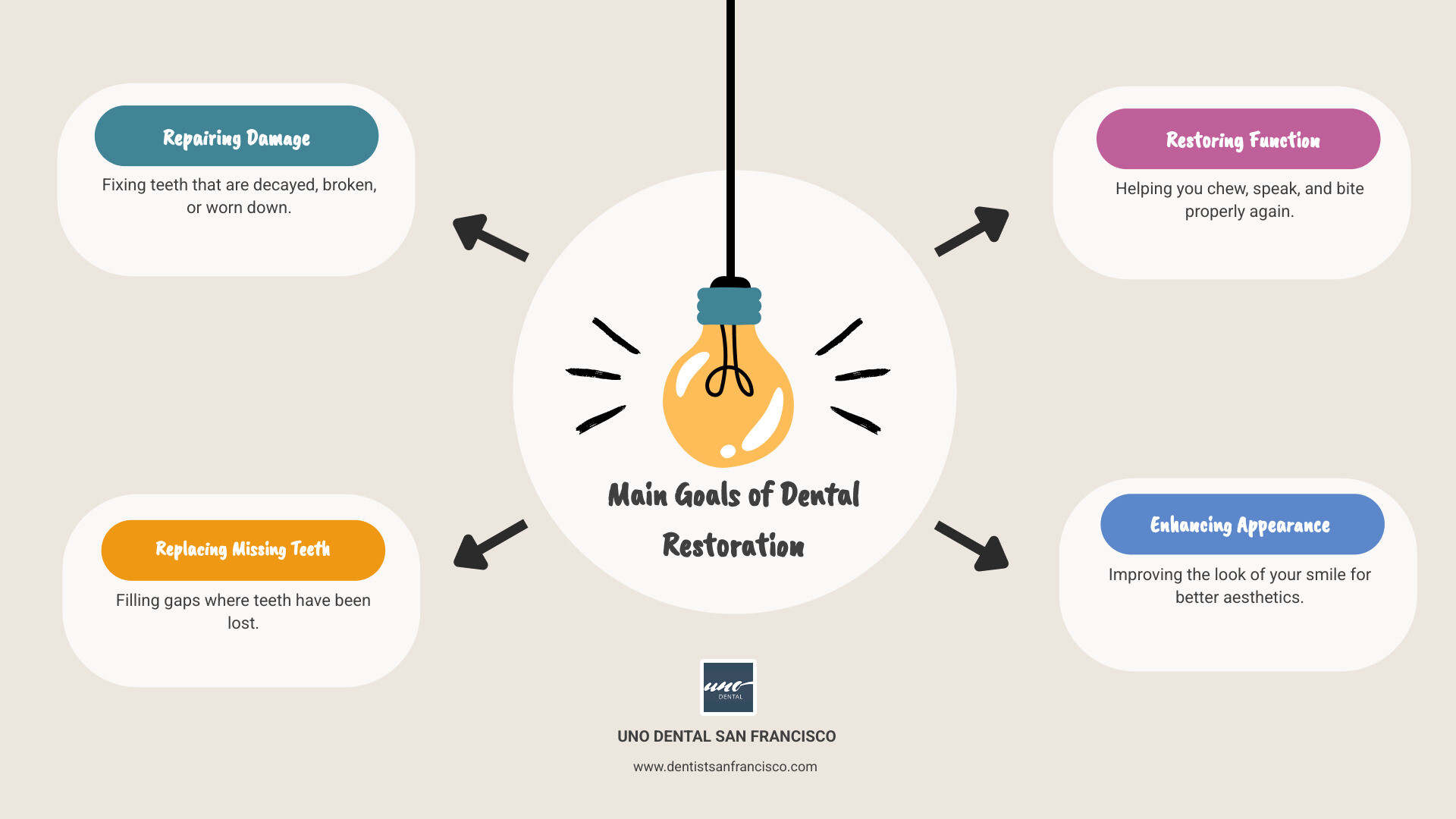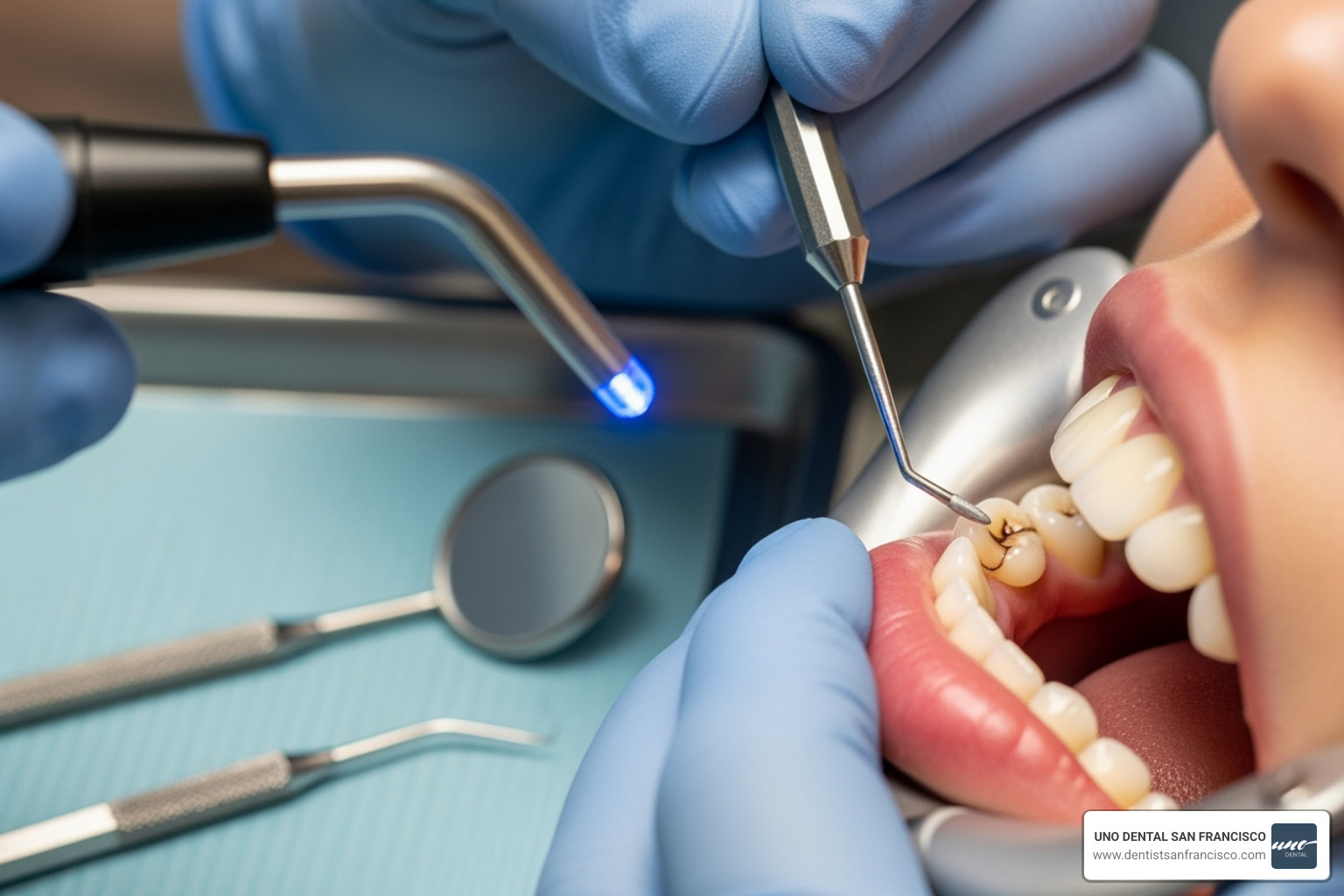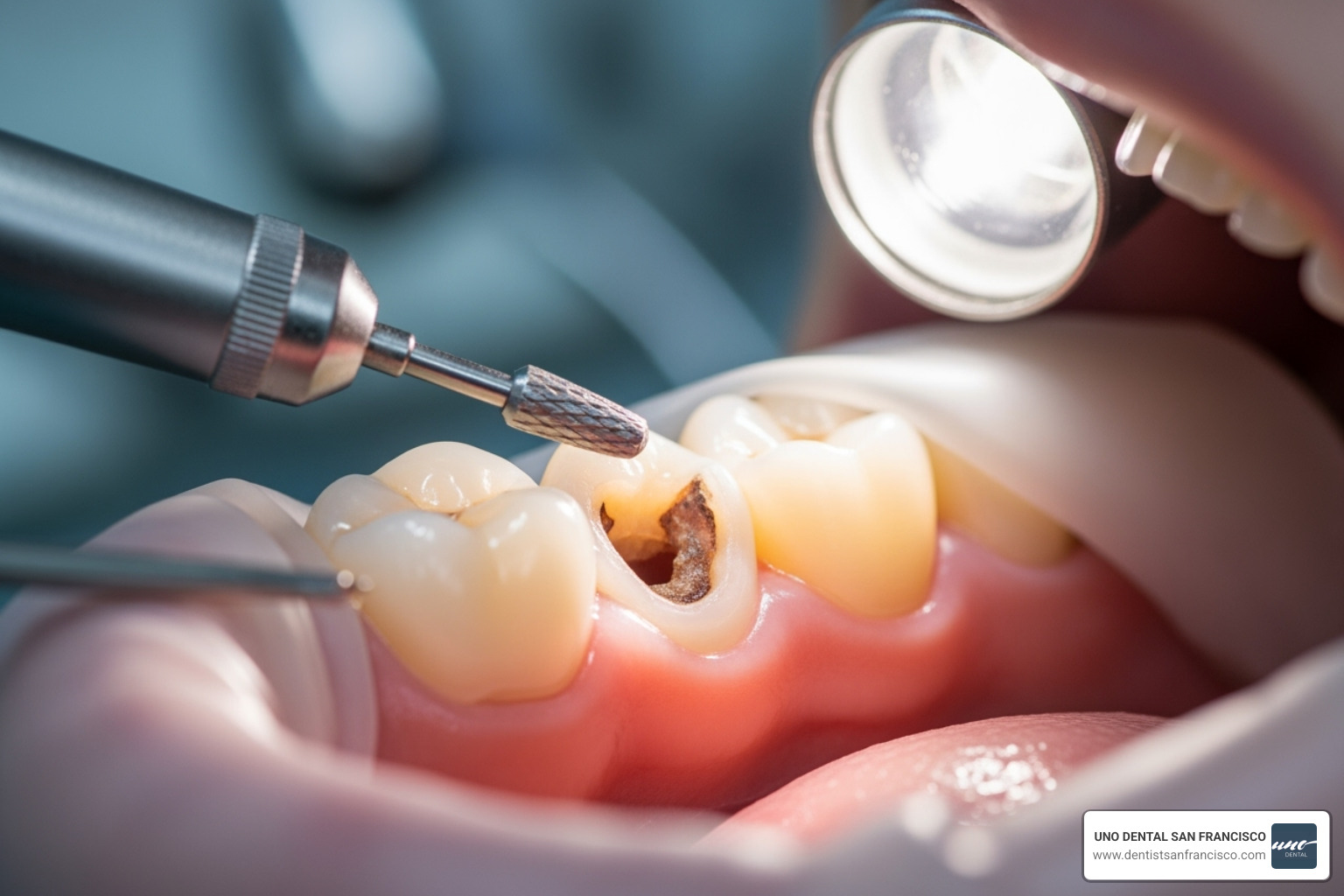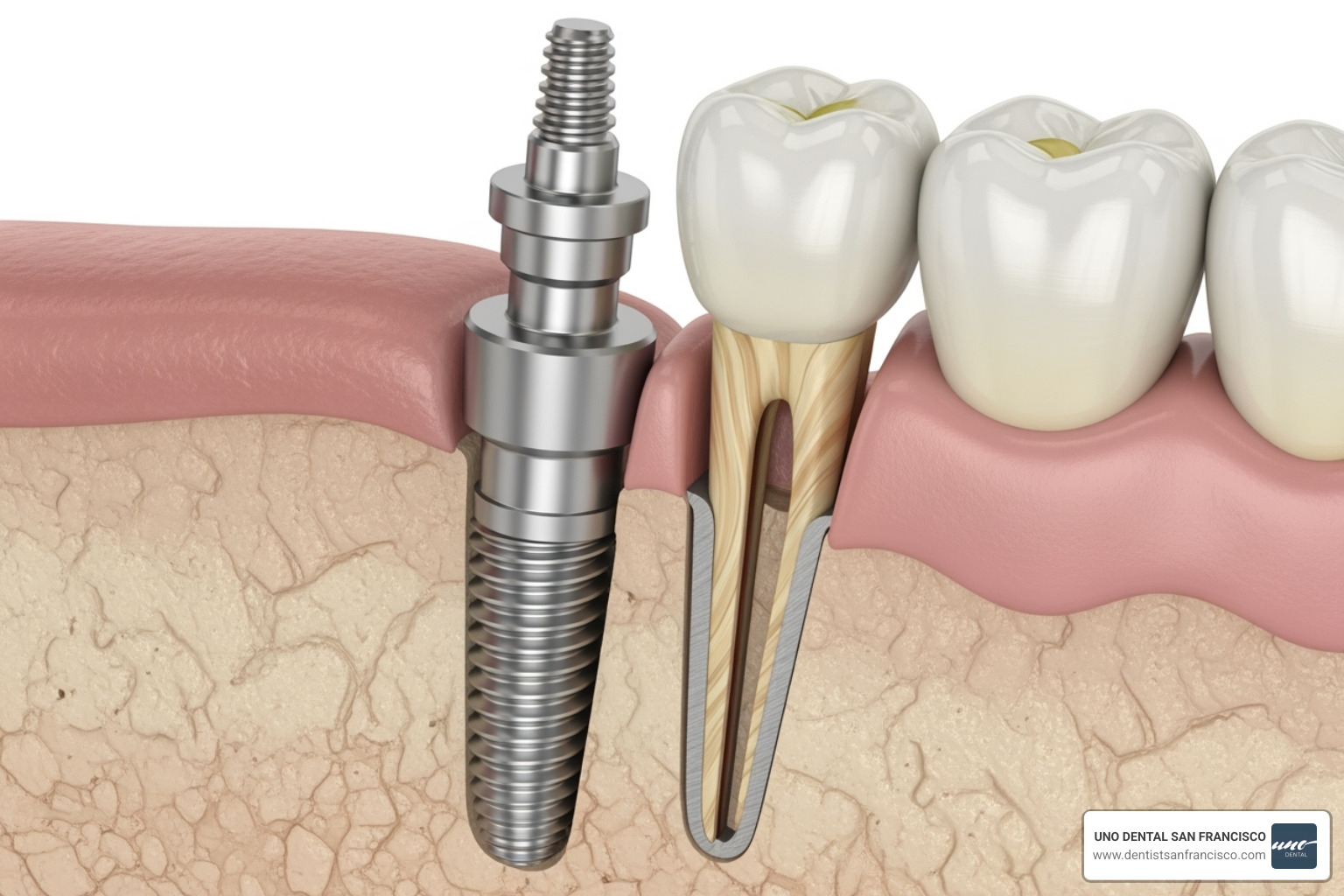
Restoring Your Smile's Health and Beauty
Understanding what does restoration mean in dentistry is the first step toward a healthier, more confident smile. This key area of dental care focuses on bringing your teeth back to their best.
Here's a quick look at what dental restoration involves:
- Repairing Damage: Fixing teeth that are decayed, broken, or worn down.
- Replacing Missing Teeth: Filling gaps where teeth have been lost.
- Restoring Function: Helping you chew, speak, and bite properly again.
- Enhancing Appearance: Improving the look of your smile for better aesthetics.
As dentists often say, tooth restorations are the various ways your dentist can replace missing teeth or repair missing parts of the tooth structure. This field tackles issues like cavities, broken teeth, or missing teeth, aiming to make your smile both healthy and beautiful.
With over 15 years in dentistry, I, Dr. Mohammad Aghiad Kandar, have mastered what does restoration mean in dentistry to provide comprehensive solutions. My experience in complex restorative treatments ensures top-tier results in oral health for my patients.
Learn more about what does restoration mean in dentistry:
What Does Restoration Mean in Dentistry? A Comprehensive Definition
When we talk about what does restoration mean in dentistry, we mean treatments designed to repair, replace, or restore the natural function and beauty of your teeth. The main goal is to fix damage and improve your oral health.
Your teeth are essential for chewing, speaking, and maintaining your facial structure. Damage like a cavity, chip, or missing tooth can disrupt these functions. Dental restoration mends these issues, ensuring your smile is comfortable, functional, and looks great.
So, why might someone need dental restoration? Often, it's due to a few common culprits:
- Tooth Decay (Cavities): The most frequent reason for restoration. Bacteria create acids that erode tooth enamel, forming holes. According to the NIDCR, 85% of adults aged 20-34 have had cavities, making fillings a common restoration. You can read more about tooth decay prevalence from the National Institute of Dental and Craniofacial Research (NIDCR) here.
- Trauma or Injury: Accidents, falls, or sports mishaps can lead to chipped, cracked, or knocked-out teeth that require restoration.
- Fractures: Biting down on something hard or stress from grinding can cause a tooth to crack.
- Deterioration of Old Fillings: Dental work isn't permanent. Old fillings can wear down or crack, allowing new decay. For example, a 2003 study found amalgam fillings last about 12.8 years, while composite fillings last about 7.8 years. Worn-out fillings require a new restoration.
- Genetic Imperfections: Restorations can correct natural variations like short, thin, or misaligned teeth, improving both their look and function.
What does restoration mean in dentistry goes beyond simply "fixing a hole." It's about protecting your long-term oral health and ensuring your smile stays healthy and beautiful. At UNO DENTAL San Francisco, we provide personalized treatments that repair the immediate problem and support the lasting well-being of your smile.
Direct vs. Indirect Restorations: Two Main Approaches
Dental restorations fall into two main categories: direct and indirect. The right choice depends on the extent of the repair, the materials used, and the desired outcome.
Direct restorations are completed in a single visit. The dentist prepares the tooth and applies a restorative material (like composite resin) directly, then shapes and hardens it. This method is ideal for smaller issues like minor cavities or chips.
Indirect restorations require two visits. In the first, the tooth is prepared and an impression is taken. A dental lab uses this to create a custom restoration. On the second visit, the restoration is bonded to the tooth. This approach is used for significant damage and often involves stronger materials like porcelain or ceramic for a precise, durable fit.
At UNO DENTAL, we call all these procedures "restorations" because our goal is to restore your tooth's original strength, function, and appearance. Indirect restorations often provide a higher quality, longer-lasting outcome due to their precision. This reflects our commitment to genuinely restoring your long-term oral health.
Common Types of Direct Dental Restorations
Direct dental restorations are our first choice for minor to moderate issues. These treatments are completed in a single visit, allowing you to leave with a restored smile the same day. The process involves placing a soft, moldable material directly into the prepared tooth, which then hardens to restore its shape and strength. It's a convenient and effective repair method.
Dental Fillings
Dental fillings are the most common type of tooth restoration. They are used to treat cavities by removing the decay and filling the space. This stops the decay, protects the tooth, and restores chewing function.
We use a few different materials for dental fillings:
- Composite Resin Fillings: Known as "tooth-colored fillings," these can be matched to your natural tooth shade. Made of a plastic and glass blend, the material bonds directly to the tooth, often preserving more healthy tooth structure. They are a popular choice for visible teeth.
- Amalgam Fillings: These traditional "silver fillings" are made from a metal mix. Amalgam is very strong and durable, ideal for back teeth. Leading health organizations confirm their safety, though their dark color makes them less suitable for visible areas.
- Glass Ionomer Fillings: These fillings release fluoride, which helps protect the tooth from future decay. They bond well to the tooth and are often used for smaller cavities or as a protective layer. While not as strong as other materials, they offer unique benefits, especially for younger patients.
At UNO DENTAL San Francisco, we discuss the best filling material for your unique needs, considering the cavity's location, size, aesthetics, and your overall oral health goals.
Learn more about tooth-colored fillings here!
Dental Bonding
Dental bonding is another direct restoration technique with both cosmetic and restorative benefits. It's an excellent solution for minor imperfections that affect your smile's appearance.
With dental bonding, we use a tooth-colored composite resin to:
- Repair chipped or cracked teeth.
- Close small gaps between teeth.
- Cover tooth discoloration.
- Change the shape of teeth.
The bonding process is quick and often requires no anesthesia. We mold the color-matched composite resin to blend seamlessly with your teeth, providing a minimally invasive way to improve your smile's look and function!
Common Types of Indirect Dental Restorations
When damage is too extensive for a filling or teeth are missing, we use indirect restorations. These are not quick fixes; they are custom-crafted in a dental lab for a perfect fit and exceptional results. The benefit of indirect restorations is their precision and durability. Though they require two visits, they are built to last for decades and look incredibly natural.
Dental Crowns (Caps)
A dental crown is a custom-made cap that covers an entire tooth, providing strength and protection when the natural tooth is compromised. We recommend crowns for teeth weakened by extensive decay, large fillings, or cracks. They are also essential after a root canal to protect the brittle tooth. Crowns also serve as anchors for dental bridges and top off dental implants.
Materials like porcelain and ceramic offer natural beauty, while Zirconia crowns provide exceptional strength. For maximum durability, gold and metal alloys are also an option. At UNO DENTAL San Francisco, our CEREC technology allows us to offer same-day crowns. We can design, create, and place your ceramic crown in a single visit.
Dental Bridges
A dental bridge replaces one or more missing teeth, restoring function and appearance. It uses adjacent healthy teeth as anchors to support a replacement tooth (a pontic). We place crowns on the adjacent teeth (abutment teeth) to hold the artificial tooth firmly in place. Bridges prevent remaining teeth from shifting and help maintain your facial structure.
Inlays and Onlays
Inlays and onlays, or "partial crowns," are used when damage is too extensive for a filling but not severe enough for a full crown. Inlays fit within the cusps (pointed parts) of a tooth, while onlays cover one or more cusps. Crafted from porcelain, ceramic, or gold, they offer superior strength while preserving more natural tooth structure than a full crown.
Dental Implants
Dental implants are considered the gold standard for tooth replacement. An implant is an artificial tooth root made of biocompatible titanium placed into the jawbone. It fuses with the bone through osseointegration, creating a strong foundation for a crown, bridge, or denture. The system includes the titanium post, a connector called an abutment, and a custom crown.
Implants are unique because they prevent bone loss by stimulating the jawbone, which preserves your facial structure. At UNO DENTAL San Francisco, we use a holistic approach with biocompatible materials for optimal long-term results.
Dentures
Modern dentures are an advanced, practical, and affordable solution for replacing multiple teeth or a full arch. Full dentures replace all teeth in an arch, while partial dentures are used when some natural teeth remain, attaching with clasps.
While traditional dentures are a non-surgical option, implant-supported dentures offer improved stability. A few implants are used to anchor the denture securely, eliminating slipping and the need for adhesives.
Choosing the Right Restoration: Materials and Longevity
Choosing the right dental restoration can feel overwhelming. At UNO DENTAL San Francisco, we help you make the best decision for your unique situation. There is no one-size-fits-all answer, as every patient's needs are different.
Several factors guide our recommendation:
- Extent of damage: This is the primary factor. A small cavity requires a different solution than a cracked front tooth or a missing molar.
- Tooth location: Front teeth require aesthetic materials like porcelain or composite resin. Back molars need durable materials to handle chewing forces.
- Cost and insurance: Dental care is an investment. We are transparent about pricing and help with insurance benefits. We also offer free virtual smile consultations to discuss your options.
- Patient goals: Your preferences for aesthetics, longevity, biocompatibility, or treatment speed are crucial to our recommendation.
- Overall oral health: Underlying issues like gum disease or low bone density may need to be addressed before certain restorations, like implants, can be placed.
To help you understand your options, here's how common restorative materials compare:
| Material | Aesthetics | Durability | Cost (relative) | Average Lifespan (approx.) |
|---|---|---|---|---|
| Composite Resin | Excellent (tooth-colored) | Moderate | Moderate | 7.8 years* |
| Amalgam | Poor (silver/dark) | High | Low | 12.8 years* |
| Porcelain/Ceramic | Excellent (natural) | High (can be brittle) | High | 5-15+ years (crowns/veneers) |
| Gold | Poor (metallic) | Excellent | Very High | Very Long (often decades) |
*Based on a 2003 study on fillings. Your results may vary based on oral hygiene, habits, and the tooth's location.
- Composite resin offers a natural, tooth-colored appearance. It is moderately priced and bonds well but may not last as long as other materials.
- Amalgam is not aesthetically pleasing but is very durable and cost-effective, often lasting for decades in back teeth.
- Porcelain and ceramic provide the most natural look and great durability at a higher cost. They are ideal for crowns and veneers in visible areas.
- Gold restorations are extremely long-lasting. While not aesthetically popular, they are an excellent choice for back teeth when longevity is the priority.
We always remind our patients that no dental restoration is as good as your natural tooth. Our holistic approach at UNO DENTAL focuses on preserving natural tooth structure. When a restoration is needed, we choose the most biocompatible, durable solution for your needs, clarifying what does restoration mean in dentistry for you.
Frequently Asked Questions about Dental Restorations
It's normal to have questions about dental work. Here are answers to some common questions about dental restorations.
How long do dental restorations last?
The lifespan of a dental restoration varies depending on several factors:
- Material: Different materials have different lifespans. A composite resin filling may last about 7.8 years, while a durable amalgam filling can last for 12.8 years on average, according to a 2003 study.
- Type of Restoration: Major restorations like dental crowns and dental implants are designed to be more long-lasting, often for 15-20 years or even a lifetime with proper care.
- Location: Restorations on back molars endure more stress from chewing than those on front teeth.
- Oral Care Habits: This is the biggest factor you control. Diligent brushing, flossing, and regular dental check-ups are crucial. Poor hygiene can lead to new decay or gum issues, shortening the restoration's life.
- Lifestyle Habits: Clenching or grinding your teeth (bruxism) or chewing on hard objects can put extra strain on restorations.
At UNO DENTAL San Francisco, we provide clear expectations for your restoration's lifespan and guide you on how to care for it properly.
Is getting a dental restoration painful?
We understand concerns about discomfort and strive to make your restoration experience as comfortable as possible. For most procedures, we use local anesthesia to numb the area, so you won't feel sharp pain. You might feel some pressure or vibration, but the process is generally pain-free.
After the anesthesia wears off, some mild, temporary discomfort or sensitivity is normal, especially after fillings or crowns. This may include:
- Sensitivity to hot or cold temperatures.
- Tenderness when biting.
- A mild ache that can be managed with over-the-counter pain relievers.
For more extensive procedures like dental implants, we provide detailed aftercare instructions to keep you comfortable. Your well-being is our top priority.
Can a restored tooth get another cavity?
Yes, a restored tooth can get another cavity. It's a common misconception that restorations make a tooth immune to future decay. While the restoration material itself cannot decay, the surrounding natural tooth structure remains susceptible.
New decay typically forms in these areas:
- At the Margins: The most common spot for new decay is where the restoration meets the tooth. If not cleaned properly, bacteria can accumulate and cause a new cavity along the edge of the restoration.
- Beneath the Restoration: If the seal of a restoration breaks down over time, decay could form underneath it.
This is why excellent daily oral hygiene and regular dental check-ups are so important. Visiting us at UNO DENTAL San Francisco for professional cleanings and exams helps us detect any new decay early, allowing for a simpler fix and preserving your restoration.
Your Path to a Healthy, Restored Smile
Understanding what does restoration mean in dentistry is the first step toward optimal oral health and a confident smile. Dental restoration includes procedures from simple fillings to complex implants, all designed to repair, replace, and refresh your teeth, restoring their natural beauty and function.
Restoring your smile offers many benefits:
- Restored Function: You'll be able to chew and speak comfortably without worry.
- Improved Aesthetics: Repairing chips, brightening teeth, or replacing missing ones can transform your smile and boost your confidence.
- Overall Oral Health: Restorations are crucial for your long-term health. They prevent further decay, stop teeth from shifting, and protect your jawbone.
- Prevention of Future Problems: This proactive care helps prevent more complex issues down the road.
At UNO DENTAL San Francisco, we provide comprehensive, patient-centered dental services. Our high-tech, holistic approach uses advanced tools and biocompatible materials, considering your overall well-being in every treatment plan.
Because every smile is unique, we offer individualized treatments. We guide you through your options, answer your questions, and provide free virtual smile consultations to help you explore your possibilities from home.
Don't let damaged or missing teeth hold you back. Let us help you refind the joy of a healthy, beautiful smile.



